Analyzing Leadership and Strategies for Effective Industrial Relations
VerifiedAdded on 2023/06/04
|8
|1854
|218
Report
AI Summary
This report examines the crucial role of leadership in shaping industrial relations within organizations. It delves into various leadership styles and their impact on employee-employer relationships, highlighting the challenges faced by leaders in maintaining positive industrial relations. The report includes an interview with a Minister for Industrial Relations, providing practical insights into strategies for enhancing workplace dynamics, promoting ethical values, and fostering employee confidence. Recommendations emphasize the importance of situational leadership, clear communication of organizational goals, and proactive conflict resolution to achieve successful human resource objectives and overall business strategy. Desklib provides access to similar solved assignments.
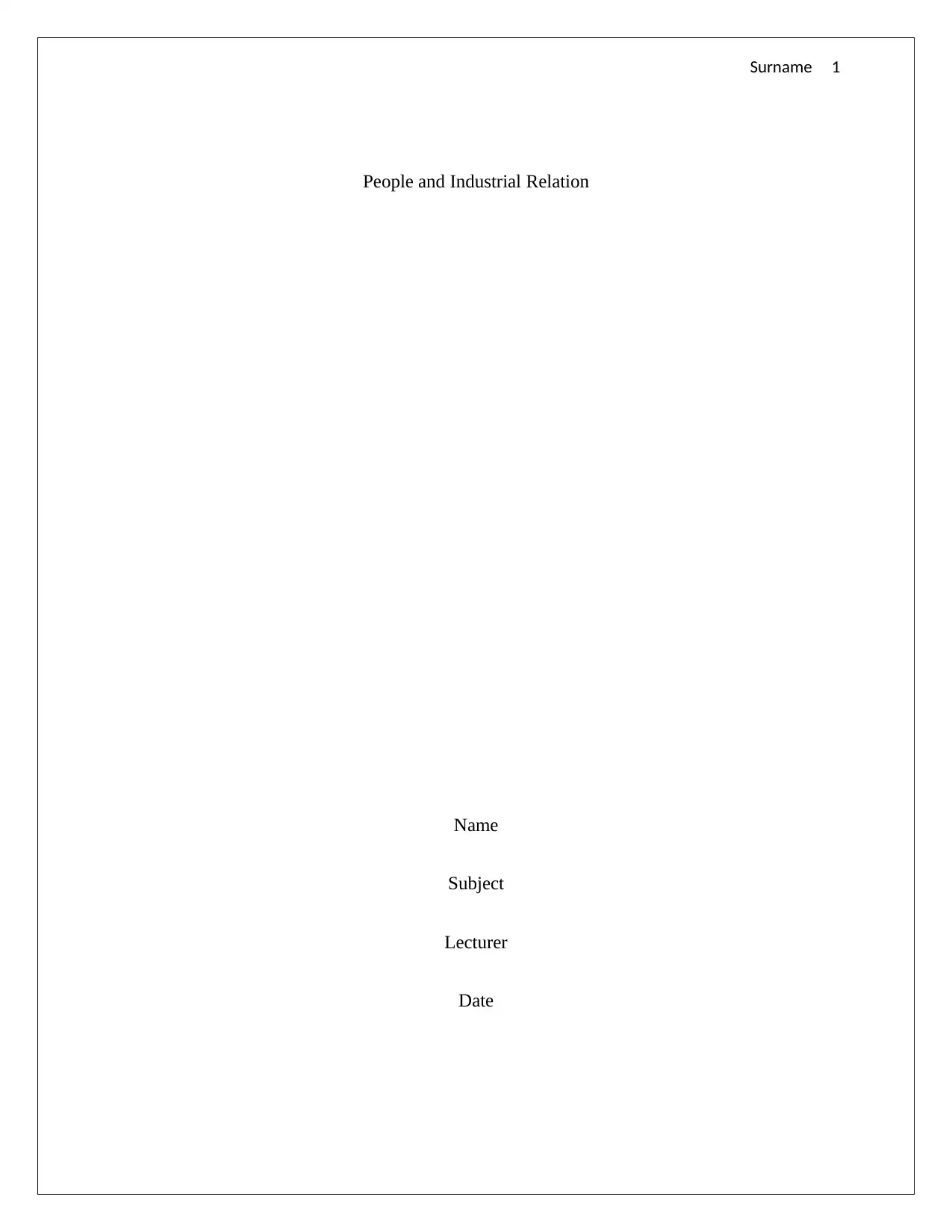
Surname 1
People and Industrial Relation
Name
Subject
Lecturer
Date
People and Industrial Relation
Name
Subject
Lecturer
Date
Paraphrase This Document
Need a fresh take? Get an instant paraphrase of this document with our AI Paraphraser
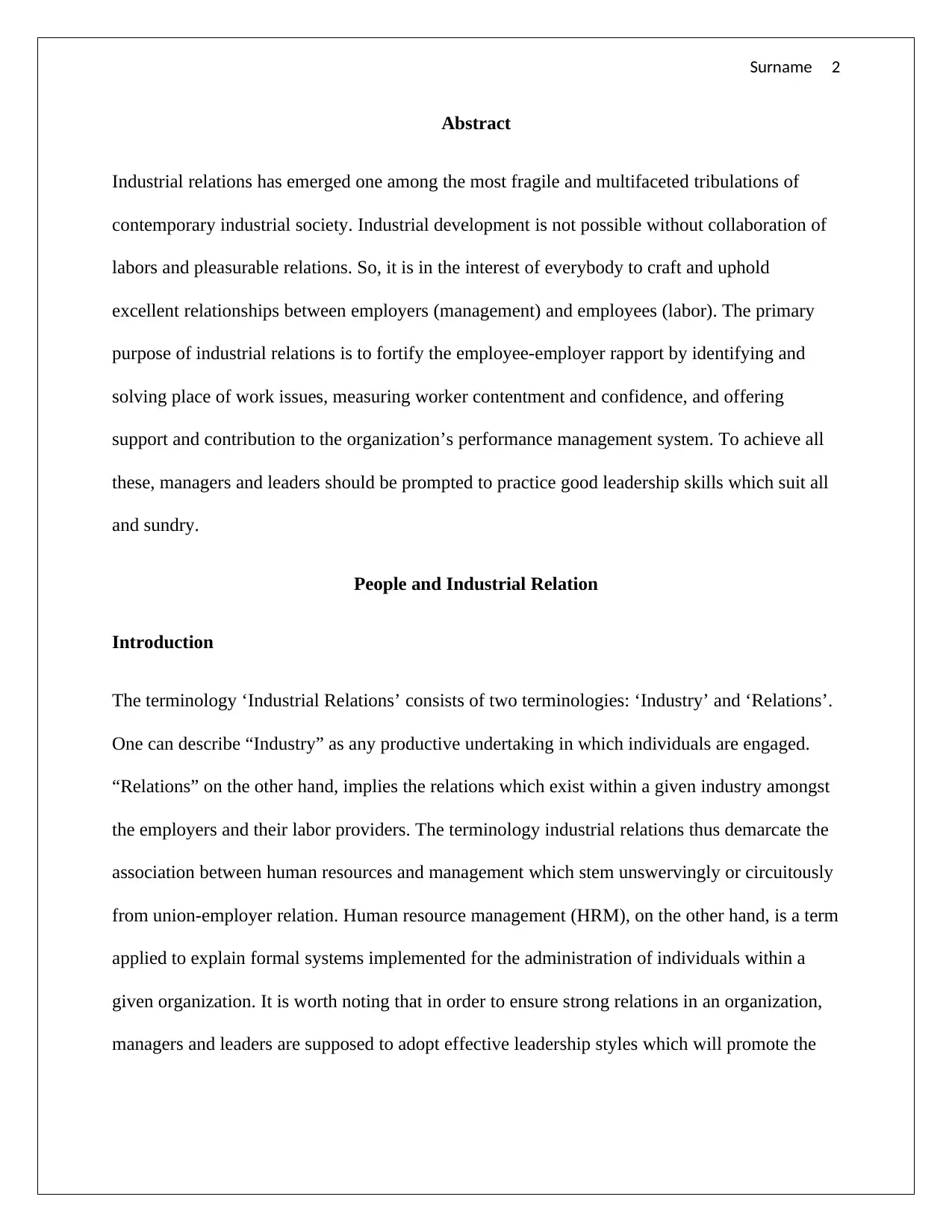
Surname 2
Abstract
Industrial relations has emerged one among the most fragile and multifaceted tribulations of
contemporary industrial society. Industrial development is not possible without collaboration of
labors and pleasurable relations. So, it is in the interest of everybody to craft and uphold
excellent relationships between employers (management) and employees (labor). The primary
purpose of industrial relations is to fortify the employee-employer rapport by identifying and
solving place of work issues, measuring worker contentment and confidence, and offering
support and contribution to the organization’s performance management system. To achieve all
these, managers and leaders should be prompted to practice good leadership skills which suit all
and sundry.
People and Industrial Relation
Introduction
The terminology ‘Industrial Relations’ consists of two terminologies: ‘Industry’ and ‘Relations’.
One can describe “Industry” as any productive undertaking in which individuals are engaged.
“Relations” on the other hand, implies the relations which exist within a given industry amongst
the employers and their labor providers. The terminology industrial relations thus demarcate the
association between human resources and management which stem unswervingly or circuitously
from union-employer relation. Human resource management (HRM), on the other hand, is a term
applied to explain formal systems implemented for the administration of individuals within a
given organization. It is worth noting that in order to ensure strong relations in an organization,
managers and leaders are supposed to adopt effective leadership styles which will promote the
Abstract
Industrial relations has emerged one among the most fragile and multifaceted tribulations of
contemporary industrial society. Industrial development is not possible without collaboration of
labors and pleasurable relations. So, it is in the interest of everybody to craft and uphold
excellent relationships between employers (management) and employees (labor). The primary
purpose of industrial relations is to fortify the employee-employer rapport by identifying and
solving place of work issues, measuring worker contentment and confidence, and offering
support and contribution to the organization’s performance management system. To achieve all
these, managers and leaders should be prompted to practice good leadership skills which suit all
and sundry.
People and Industrial Relation
Introduction
The terminology ‘Industrial Relations’ consists of two terminologies: ‘Industry’ and ‘Relations’.
One can describe “Industry” as any productive undertaking in which individuals are engaged.
“Relations” on the other hand, implies the relations which exist within a given industry amongst
the employers and their labor providers. The terminology industrial relations thus demarcate the
association between human resources and management which stem unswervingly or circuitously
from union-employer relation. Human resource management (HRM), on the other hand, is a term
applied to explain formal systems implemented for the administration of individuals within a
given organization. It is worth noting that in order to ensure strong relations in an organization,
managers and leaders are supposed to adopt effective leadership styles which will promote the
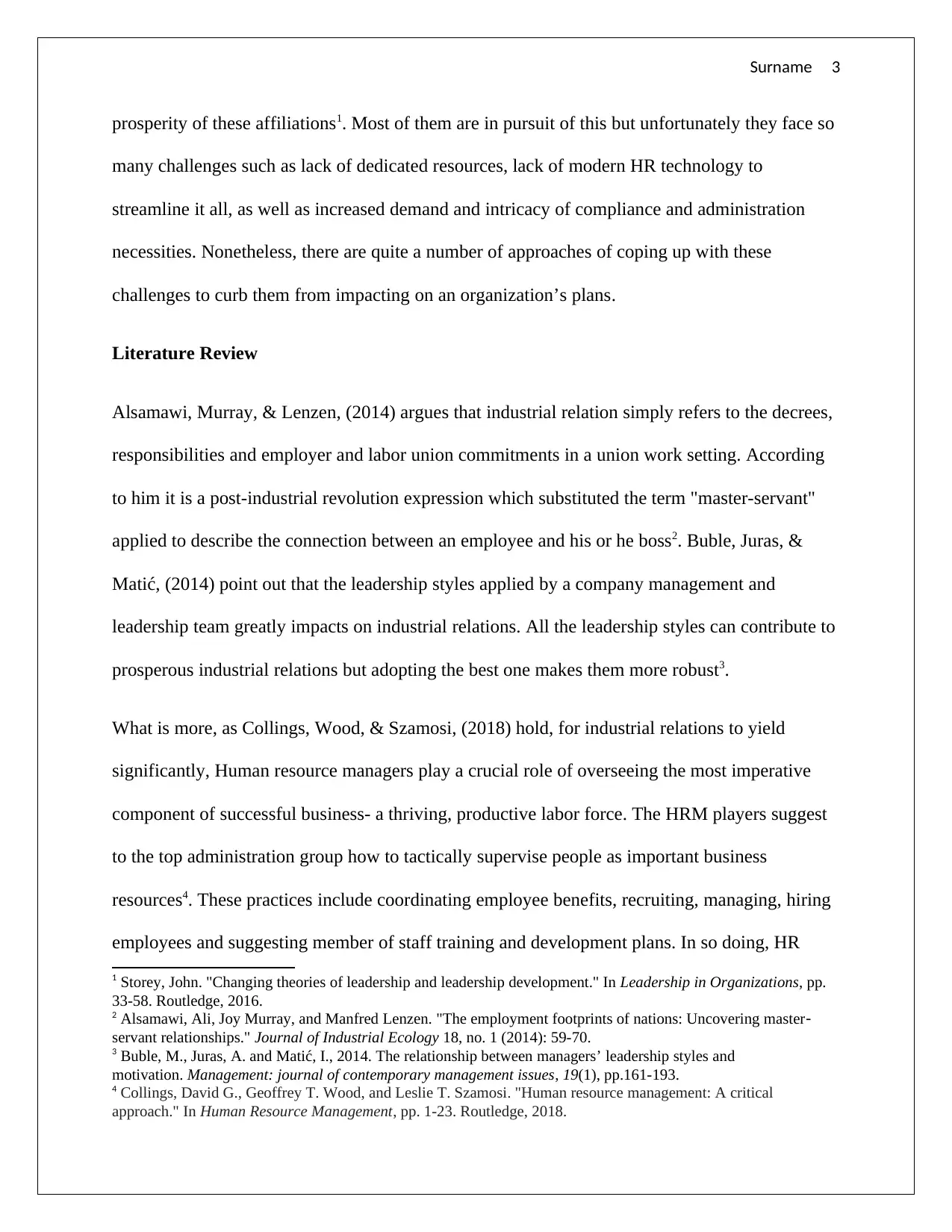
Surname 3
prosperity of these affiliations1. Most of them are in pursuit of this but unfortunately they face so
many challenges such as lack of dedicated resources, lack of modern HR technology to
streamline it all, as well as increased demand and intricacy of compliance and administration
necessities. Nonetheless, there are quite a number of approaches of coping up with these
challenges to curb them from impacting on an organization’s plans.
Literature Review
Alsamawi, Murray, & Lenzen, (2014) argues that industrial relation simply refers to the decrees,
responsibilities and employer and labor union commitments in a union work setting. According
to him it is a post-industrial revolution expression which substituted the term "master-servant"
applied to describe the connection between an employee and his or he boss2. Buble, Juras, &
Matić, (2014) point out that the leadership styles applied by a company management and
leadership team greatly impacts on industrial relations. All the leadership styles can contribute to
prosperous industrial relations but adopting the best one makes them more robust3.
What is more, as Collings, Wood, & Szamosi, (2018) hold, for industrial relations to yield
significantly, Human resource managers play a crucial role of overseeing the most imperative
component of successful business- a thriving, productive labor force. The HRM players suggest
to the top administration group how to tactically supervise people as important business
resources4. These practices include coordinating employee benefits, recruiting, managing, hiring
employees and suggesting member of staff training and development plans. In so doing, HR
1 Storey, John. "Changing theories of leadership and leadership development." In Leadership in Organizations, pp.
33-58. Routledge, 2016.
2 Alsamawi, Ali, Joy Murray, and Manfred Lenzen. "The employment footprints of nations: Uncovering master‐
servant relationships." Journal of Industrial Ecology 18, no. 1 (2014): 59-70.
3 Buble, M., Juras, A. and Matić, I., 2014. The relationship between managers’ leadership styles and
motivation. Management: journal of contemporary management issues, 19(1), pp.161-193.
4 Collings, David G., Geoffrey T. Wood, and Leslie T. Szamosi. "Human resource management: A critical
approach." In Human Resource Management, pp. 1-23. Routledge, 2018.
prosperity of these affiliations1. Most of them are in pursuit of this but unfortunately they face so
many challenges such as lack of dedicated resources, lack of modern HR technology to
streamline it all, as well as increased demand and intricacy of compliance and administration
necessities. Nonetheless, there are quite a number of approaches of coping up with these
challenges to curb them from impacting on an organization’s plans.
Literature Review
Alsamawi, Murray, & Lenzen, (2014) argues that industrial relation simply refers to the decrees,
responsibilities and employer and labor union commitments in a union work setting. According
to him it is a post-industrial revolution expression which substituted the term "master-servant"
applied to describe the connection between an employee and his or he boss2. Buble, Juras, &
Matić, (2014) point out that the leadership styles applied by a company management and
leadership team greatly impacts on industrial relations. All the leadership styles can contribute to
prosperous industrial relations but adopting the best one makes them more robust3.
What is more, as Collings, Wood, & Szamosi, (2018) hold, for industrial relations to yield
significantly, Human resource managers play a crucial role of overseeing the most imperative
component of successful business- a thriving, productive labor force. The HRM players suggest
to the top administration group how to tactically supervise people as important business
resources4. These practices include coordinating employee benefits, recruiting, managing, hiring
employees and suggesting member of staff training and development plans. In so doing, HR
1 Storey, John. "Changing theories of leadership and leadership development." In Leadership in Organizations, pp.
33-58. Routledge, 2016.
2 Alsamawi, Ali, Joy Murray, and Manfred Lenzen. "The employment footprints of nations: Uncovering master‐
servant relationships." Journal of Industrial Ecology 18, no. 1 (2014): 59-70.
3 Buble, M., Juras, A. and Matić, I., 2014. The relationship between managers’ leadership styles and
motivation. Management: journal of contemporary management issues, 19(1), pp.161-193.
4 Collings, David G., Geoffrey T. Wood, and Leslie T. Szamosi. "Human resource management: A critical
approach." In Human Resource Management, pp. 1-23. Routledge, 2018.
⊘ This is a preview!⊘
Do you want full access?
Subscribe today to unlock all pages.

Trusted by 1+ million students worldwide
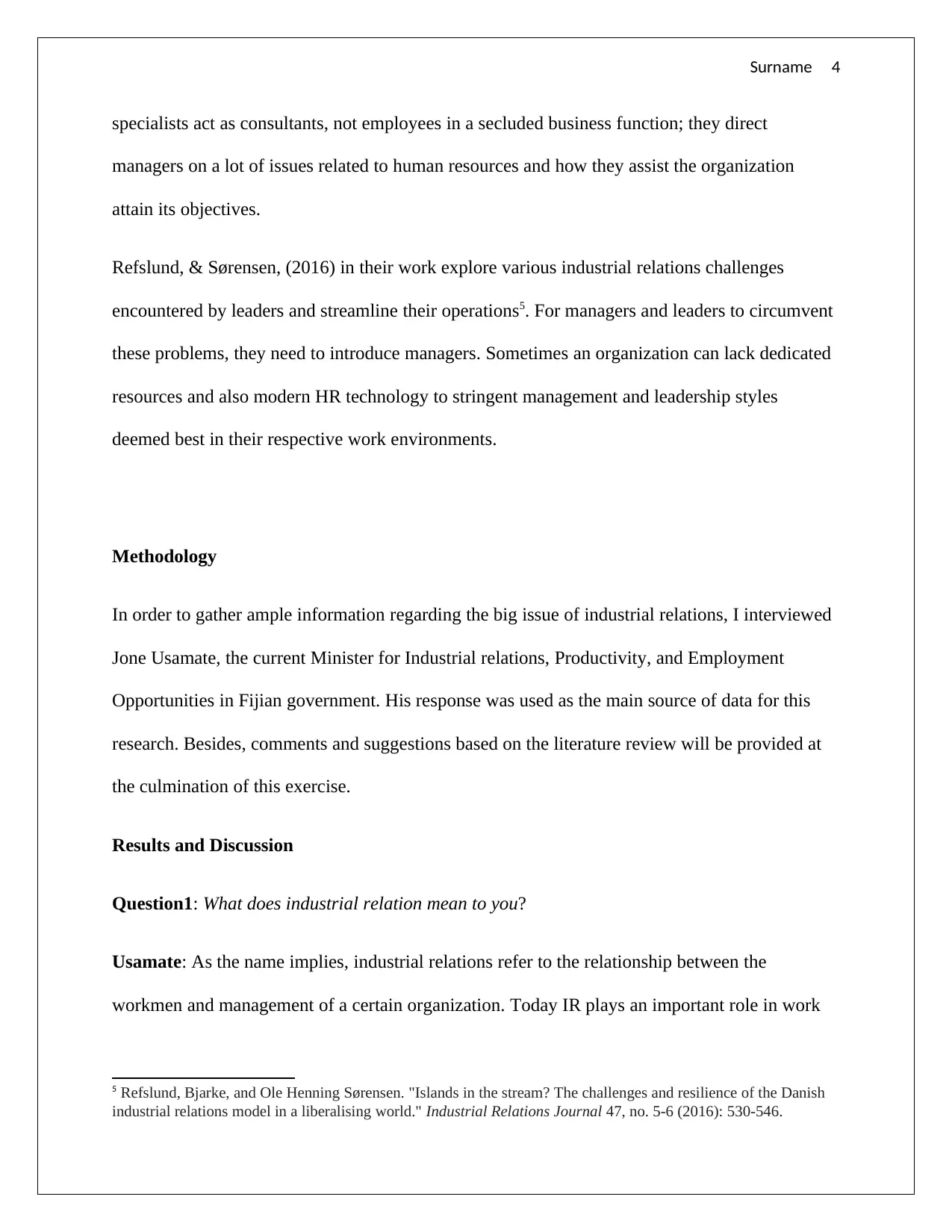
Surname 4
specialists act as consultants, not employees in a secluded business function; they direct
managers on a lot of issues related to human resources and how they assist the organization
attain its objectives.
Refslund, & Sørensen, (2016) in their work explore various industrial relations challenges
encountered by leaders and streamline their operations5. For managers and leaders to circumvent
these problems, they need to introduce managers. Sometimes an organization can lack dedicated
resources and also modern HR technology to stringent management and leadership styles
deemed best in their respective work environments.
Methodology
In order to gather ample information regarding the big issue of industrial relations, I interviewed
Jone Usamate, the current Minister for Industrial relations, Productivity, and Employment
Opportunities in Fijian government. His response was used as the main source of data for this
research. Besides, comments and suggestions based on the literature review will be provided at
the culmination of this exercise.
Results and Discussion
Question1: What does industrial relation mean to you?
Usamate: As the name implies, industrial relations refer to the relationship between the
workmen and management of a certain organization. Today IR plays an important role in work
5 Refslund, Bjarke, and Ole Henning Sørensen. "Islands in the stream? The challenges and resilience of the Danish
industrial relations model in a liberalising world." Industrial Relations Journal 47, no. 5-6 (2016): 530-546.
specialists act as consultants, not employees in a secluded business function; they direct
managers on a lot of issues related to human resources and how they assist the organization
attain its objectives.
Refslund, & Sørensen, (2016) in their work explore various industrial relations challenges
encountered by leaders and streamline their operations5. For managers and leaders to circumvent
these problems, they need to introduce managers. Sometimes an organization can lack dedicated
resources and also modern HR technology to stringent management and leadership styles
deemed best in their respective work environments.
Methodology
In order to gather ample information regarding the big issue of industrial relations, I interviewed
Jone Usamate, the current Minister for Industrial relations, Productivity, and Employment
Opportunities in Fijian government. His response was used as the main source of data for this
research. Besides, comments and suggestions based on the literature review will be provided at
the culmination of this exercise.
Results and Discussion
Question1: What does industrial relation mean to you?
Usamate: As the name implies, industrial relations refer to the relationship between the
workmen and management of a certain organization. Today IR plays an important role in work
5 Refslund, Bjarke, and Ole Henning Sørensen. "Islands in the stream? The challenges and resilience of the Danish
industrial relations model in a liberalising world." Industrial Relations Journal 47, no. 5-6 (2016): 530-546.
Paraphrase This Document
Need a fresh take? Get an instant paraphrase of this document with our AI Paraphraser
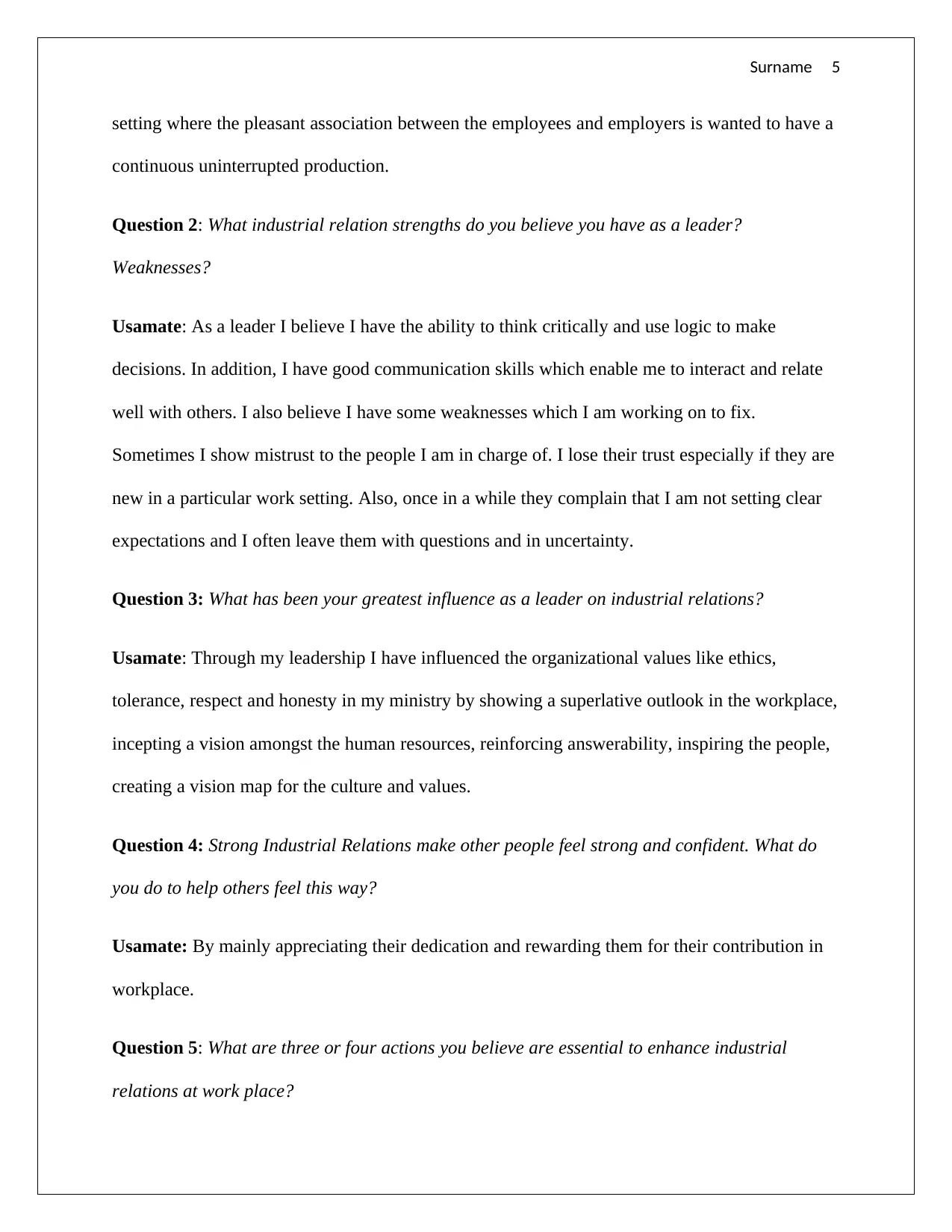
Surname 5
setting where the pleasant association between the employees and employers is wanted to have a
continuous uninterrupted production.
Question 2: What industrial relation strengths do you believe you have as a leader?
Weaknesses?
Usamate: As a leader I believe I have the ability to think critically and use logic to make
decisions. In addition, I have good communication skills which enable me to interact and relate
well with others. I also believe I have some weaknesses which I am working on to fix.
Sometimes I show mistrust to the people I am in charge of. I lose their trust especially if they are
new in a particular work setting. Also, once in a while they complain that I am not setting clear
expectations and I often leave them with questions and in uncertainty.
Question 3: What has been your greatest influence as a leader on industrial relations?
Usamate: Through my leadership I have influenced the organizational values like ethics,
tolerance, respect and honesty in my ministry by showing a superlative outlook in the workplace,
incepting a vision amongst the human resources, reinforcing answerability, inspiring the people,
creating a vision map for the culture and values.
Question 4: Strong Industrial Relations make other people feel strong and confident. What do
you do to help others feel this way?
Usamate: By mainly appreciating their dedication and rewarding them for their contribution in
workplace.
Question 5: What are three or four actions you believe are essential to enhance industrial
relations at work place?
setting where the pleasant association between the employees and employers is wanted to have a
continuous uninterrupted production.
Question 2: What industrial relation strengths do you believe you have as a leader?
Weaknesses?
Usamate: As a leader I believe I have the ability to think critically and use logic to make
decisions. In addition, I have good communication skills which enable me to interact and relate
well with others. I also believe I have some weaknesses which I am working on to fix.
Sometimes I show mistrust to the people I am in charge of. I lose their trust especially if they are
new in a particular work setting. Also, once in a while they complain that I am not setting clear
expectations and I often leave them with questions and in uncertainty.
Question 3: What has been your greatest influence as a leader on industrial relations?
Usamate: Through my leadership I have influenced the organizational values like ethics,
tolerance, respect and honesty in my ministry by showing a superlative outlook in the workplace,
incepting a vision amongst the human resources, reinforcing answerability, inspiring the people,
creating a vision map for the culture and values.
Question 4: Strong Industrial Relations make other people feel strong and confident. What do
you do to help others feel this way?
Usamate: By mainly appreciating their dedication and rewarding them for their contribution in
workplace.
Question 5: What are three or four actions you believe are essential to enhance industrial
relations at work place?
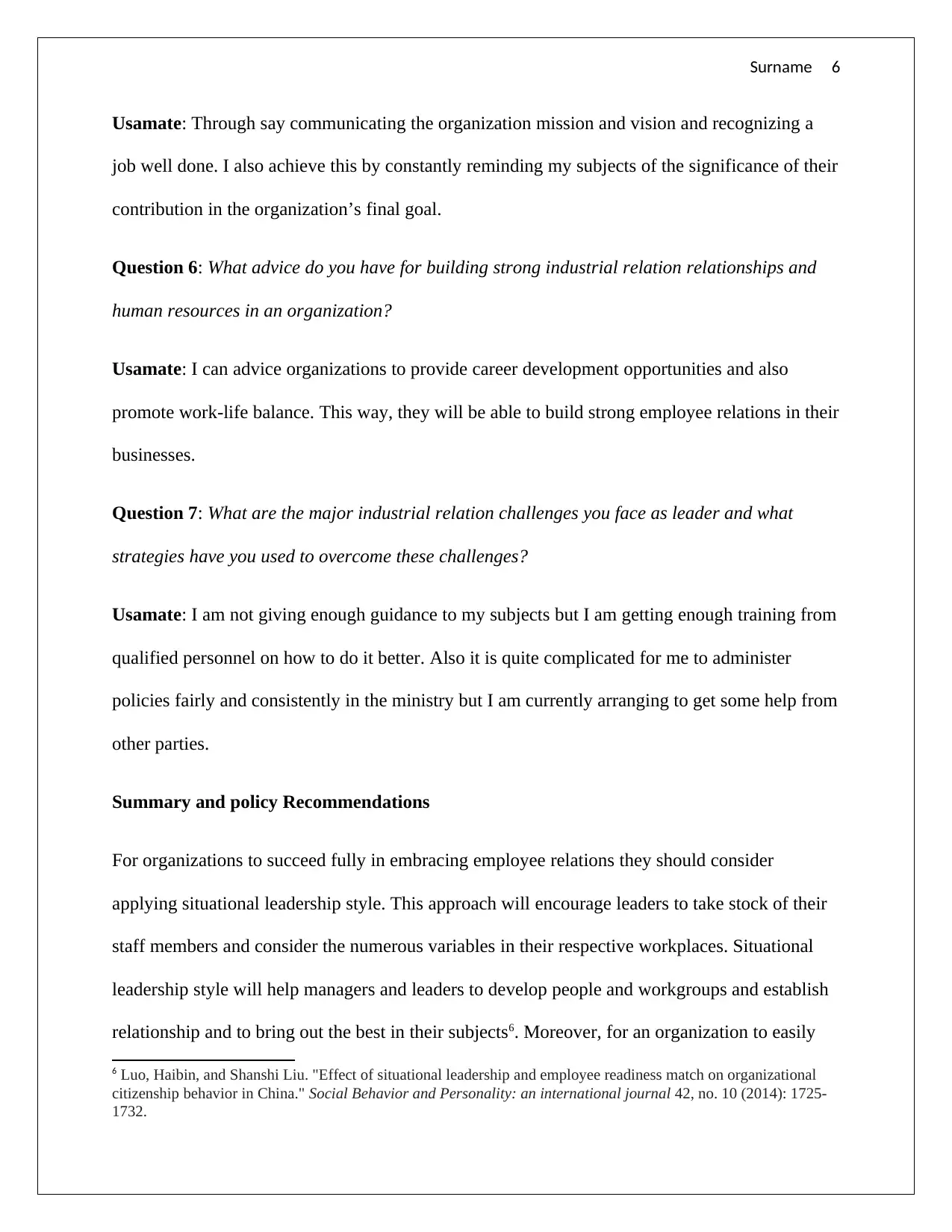
Surname 6
Usamate: Through say communicating the organization mission and vision and recognizing a
job well done. I also achieve this by constantly reminding my subjects of the significance of their
contribution in the organization’s final goal.
Question 6: What advice do you have for building strong industrial relation relationships and
human resources in an organization?
Usamate: I can advice organizations to provide career development opportunities and also
promote work-life balance. This way, they will be able to build strong employee relations in their
businesses.
Question 7: What are the major industrial relation challenges you face as leader and what
strategies have you used to overcome these challenges?
Usamate: I am not giving enough guidance to my subjects but I am getting enough training from
qualified personnel on how to do it better. Also it is quite complicated for me to administer
policies fairly and consistently in the ministry but I am currently arranging to get some help from
other parties.
Summary and policy Recommendations
For organizations to succeed fully in embracing employee relations they should consider
applying situational leadership style. This approach will encourage leaders to take stock of their
staff members and consider the numerous variables in their respective workplaces. Situational
leadership style will help managers and leaders to develop people and workgroups and establish
relationship and to bring out the best in their subjects6. Moreover, for an organization to easily
6 Luo, Haibin, and Shanshi Liu. "Effect of situational leadership and employee readiness match on organizational
citizenship behavior in China." Social Behavior and Personality: an international journal 42, no. 10 (2014): 1725-
1732.
Usamate: Through say communicating the organization mission and vision and recognizing a
job well done. I also achieve this by constantly reminding my subjects of the significance of their
contribution in the organization’s final goal.
Question 6: What advice do you have for building strong industrial relation relationships and
human resources in an organization?
Usamate: I can advice organizations to provide career development opportunities and also
promote work-life balance. This way, they will be able to build strong employee relations in their
businesses.
Question 7: What are the major industrial relation challenges you face as leader and what
strategies have you used to overcome these challenges?
Usamate: I am not giving enough guidance to my subjects but I am getting enough training from
qualified personnel on how to do it better. Also it is quite complicated for me to administer
policies fairly and consistently in the ministry but I am currently arranging to get some help from
other parties.
Summary and policy Recommendations
For organizations to succeed fully in embracing employee relations they should consider
applying situational leadership style. This approach will encourage leaders to take stock of their
staff members and consider the numerous variables in their respective workplaces. Situational
leadership style will help managers and leaders to develop people and workgroups and establish
relationship and to bring out the best in their subjects6. Moreover, for an organization to easily
6 Luo, Haibin, and Shanshi Liu. "Effect of situational leadership and employee readiness match on organizational
citizenship behavior in China." Social Behavior and Personality: an international journal 42, no. 10 (2014): 1725-
1732.
⊘ This is a preview!⊘
Do you want full access?
Subscribe today to unlock all pages.

Trusted by 1+ million students worldwide
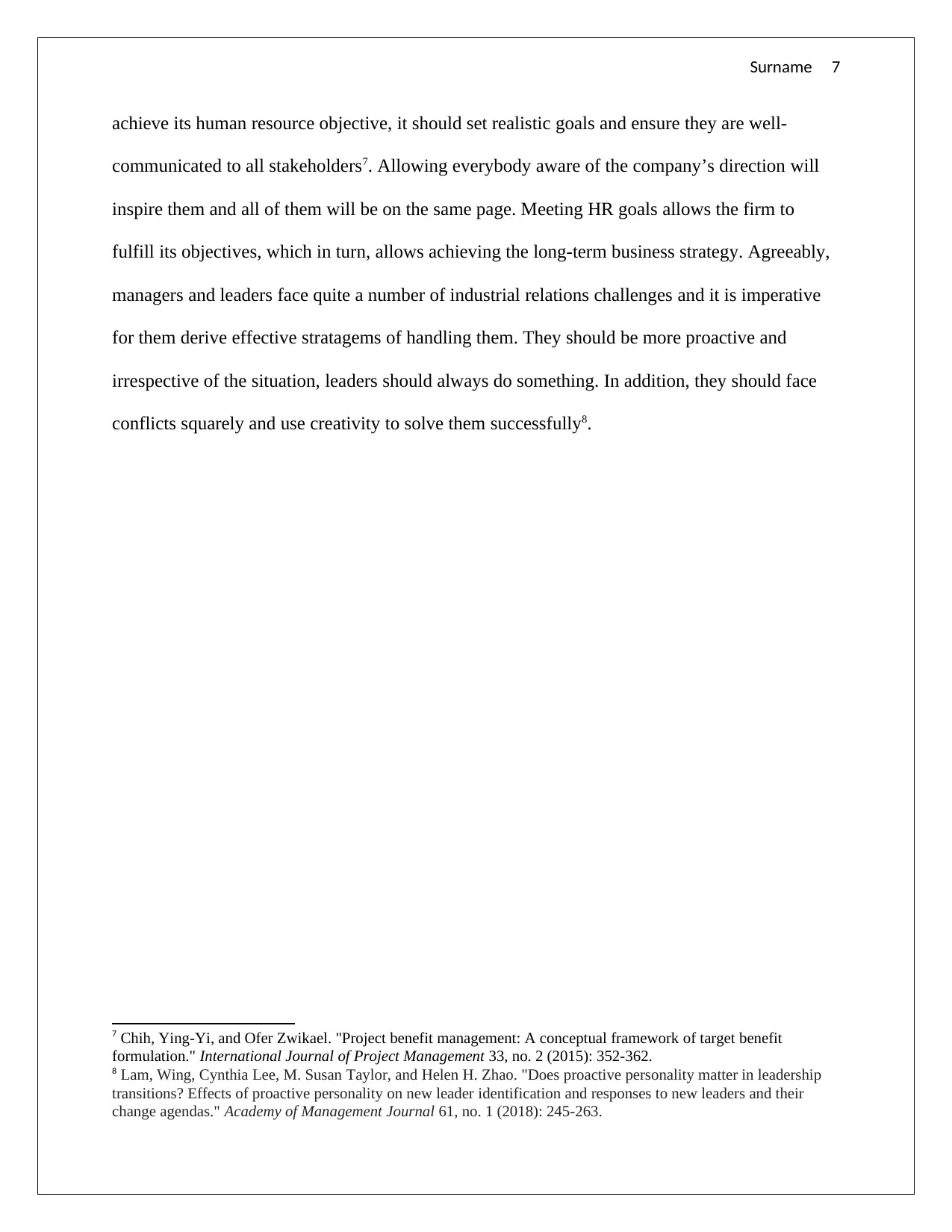
Surname 7
achieve its human resource objective, it should set realistic goals and ensure they are well-
communicated to all stakeholders7. Allowing everybody aware of the company’s direction will
inspire them and all of them will be on the same page. Meeting HR goals allows the firm to
fulfill its objectives, which in turn, allows achieving the long-term business strategy. Agreeably,
managers and leaders face quite a number of industrial relations challenges and it is imperative
for them derive effective stratagems of handling them. They should be more proactive and
irrespective of the situation, leaders should always do something. In addition, they should face
conflicts squarely and use creativity to solve them successfully8.
7 Chih, Ying-Yi, and Ofer Zwikael. "Project benefit management: A conceptual framework of target benefit
formulation." International Journal of Project Management 33, no. 2 (2015): 352-362.
8 Lam, Wing, Cynthia Lee, M. Susan Taylor, and Helen H. Zhao. "Does proactive personality matter in leadership
transitions? Effects of proactive personality on new leader identification and responses to new leaders and their
change agendas." Academy of Management Journal 61, no. 1 (2018): 245-263.
achieve its human resource objective, it should set realistic goals and ensure they are well-
communicated to all stakeholders7. Allowing everybody aware of the company’s direction will
inspire them and all of them will be on the same page. Meeting HR goals allows the firm to
fulfill its objectives, which in turn, allows achieving the long-term business strategy. Agreeably,
managers and leaders face quite a number of industrial relations challenges and it is imperative
for them derive effective stratagems of handling them. They should be more proactive and
irrespective of the situation, leaders should always do something. In addition, they should face
conflicts squarely and use creativity to solve them successfully8.
7 Chih, Ying-Yi, and Ofer Zwikael. "Project benefit management: A conceptual framework of target benefit
formulation." International Journal of Project Management 33, no. 2 (2015): 352-362.
8 Lam, Wing, Cynthia Lee, M. Susan Taylor, and Helen H. Zhao. "Does proactive personality matter in leadership
transitions? Effects of proactive personality on new leader identification and responses to new leaders and their
change agendas." Academy of Management Journal 61, no. 1 (2018): 245-263.
Paraphrase This Document
Need a fresh take? Get an instant paraphrase of this document with our AI Paraphraser
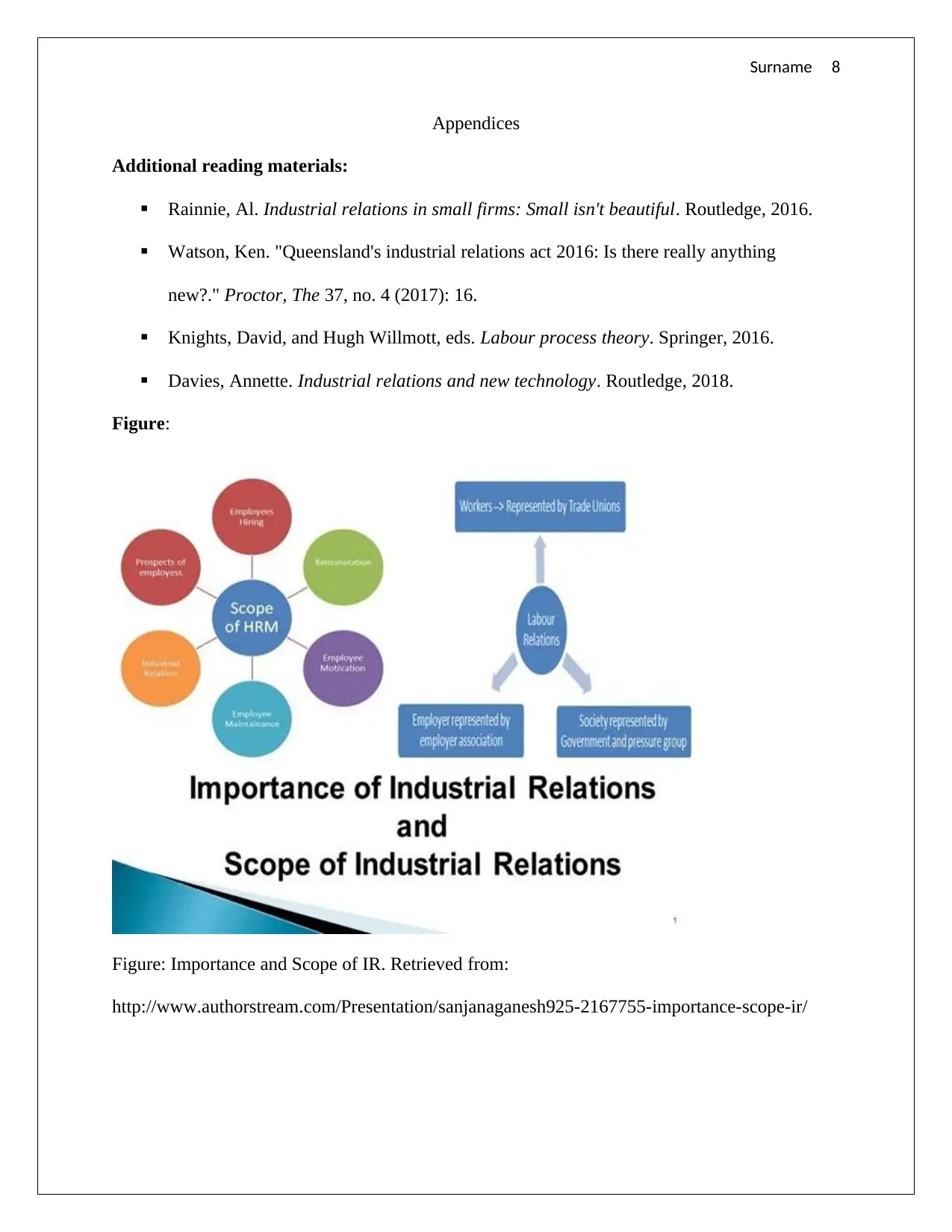
Surname 8
Appendices
Additional reading materials:
Rainnie, Al. Industrial relations in small firms: Small isn't beautiful. Routledge, 2016.
Watson, Ken. "Queensland's industrial relations act 2016: Is there really anything
new?." Proctor, The 37, no. 4 (2017): 16.
Knights, David, and Hugh Willmott, eds. Labour process theory. Springer, 2016.
Davies, Annette. Industrial relations and new technology. Routledge, 2018.
Figure:
Figure: Importance and Scope of IR. Retrieved from:
http://www.authorstream.com/Presentation/sanjanaganesh925-2167755-importance-scope-ir/
Appendices
Additional reading materials:
Rainnie, Al. Industrial relations in small firms: Small isn't beautiful. Routledge, 2016.
Watson, Ken. "Queensland's industrial relations act 2016: Is there really anything
new?." Proctor, The 37, no. 4 (2017): 16.
Knights, David, and Hugh Willmott, eds. Labour process theory. Springer, 2016.
Davies, Annette. Industrial relations and new technology. Routledge, 2018.
Figure:
Figure: Importance and Scope of IR. Retrieved from:
http://www.authorstream.com/Presentation/sanjanaganesh925-2167755-importance-scope-ir/
1 out of 8
Related Documents
Your All-in-One AI-Powered Toolkit for Academic Success.
+13062052269
info@desklib.com
Available 24*7 on WhatsApp / Email
![[object Object]](/_next/static/media/star-bottom.7253800d.svg)
Unlock your academic potential
Copyright © 2020–2025 A2Z Services. All Rights Reserved. Developed and managed by ZUCOL.


